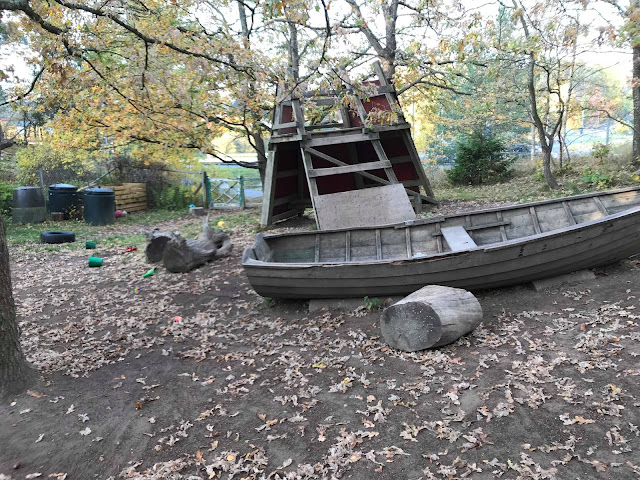I Ur och Skur means directly in hour and shower (UR is an old word for clock, or a word outside, or original as urskog means virgin forest (original untouched forest) - it can also be translated as the saying Rain or Shine - as in come rain or shine = no matter what.
The preschools we visited were Stubben and Mulleborg... Mulleborg being the first ever I Ur och Skur preschool.
What I really liked about visiting, aside from the fantastic grounds, the usage of the local nature and the enthusiastic and respectful staff was the fact there was a healthy relationship with the outdoors and indoors. These were not places that MADE the children be outside everyday all day, these were places that made the outdoors an attractive place to be so the children wanted to be there...
there is a huge difference.
The indoor area was used just about every day, and in a way that supported the children's enthusiasm for being outside.
The outside, the connection with nature was the focus but not to an extent that the children had to be outside.
Of course the preschools were successful, the children loved being outside.
The preschools chose to not have large numbers of children... so both preschools had a huge space (especially their outdoor spaces) in relation to the number of children. They also had enough staff to be able to give the attention to detail that nature requires. This allowed them to go in different size groups into the forest to explore without compromising safety. This means it gives children the space and time to engage in risky play without it being dangerous.
This is NOT forest school... this is not about schoolifying nature... this is about supporting the children to have positive relationships with nature, to play and learn naturally there, as they would anywhere else (of course in nature there is more freedom... and it can be forest, a meadow or a lake... not confined to school in a forest..)
Don't get me wrong it is GREAT that schools are getting out into nature and discovering children can learn there... discovering there is more than one way to learn.
But in a way this is something children already know... maybe forest school is more about educating adults into understanding transdisciplinary learning, new perspectives on learning, and the 100 language of learning... not JUST in a classroom with workbooks and "set activities" - a kind of controlled play.
Forest Schools are important in many places because they are that first step for the school system to learn that traditional school is not the ONLY answer.
But what I saw in these preschools was play, learning happening and being supported through play, freedom, social interactions being supported allowing for socially competent children (they have the space to develop at their own space, and not being forced into social situations before they master the skills/confidence due to small indoor spaces).
I also saw staff that believed in what they are doing, and also had a great joy for the outdoors... which sadly is not always the case, even in most Swedish preschools where I have encountered at least one (often more) pedagogues at every preschool I have spent real time at, that have not liked going outside. And this infects the children.
Creating a joyful and good relationship with the outdoors and with nature is essential. On that learning can be built.
If the children are negative or do not feel safe or inspired, then the learning and the play is never going to be as deep or as profound. Or of the kind desired by the Swedish School Authority - "Life Long Learning"
So here are some photos of the outdoor spaces to get you thinking
I fully realise not all of you will be able to create the same thing... lack of space, or policies that restrict. BUT the images can still inspire you to think what you can do in your own context.
The images are in no specific order... and in this post there will be no comments.
Tomorrow I will share some of these photos again, with comments and reflections.


























